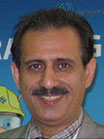A b s t r a c t
Anew, simple and highly sensitive dispersive liquid–liquid microextraction method using a ionic liquid, i.e., 1-Butyl-3-methylimidazolium hexafluorophosphate ([C4MIM][PF6]) for nickel determination at trace levels in real samples was developed. Nickel was chelated with diethyl dithiocarbamat reagent and extracted into an ionic liquid. Ni was back-extracted from the IL phase with 200 �L of 0.5 mol L-1 nitric acid and determined by electrothermal atomic absorption spectrometry (ETAAS). Various parameters such as pH, amount of ionic liquid, eluent type and volume, chelating agent concentration, volume of the sample solution and matrix interference effect on the recovery of the metal ions have been studied. Under the optimum conditions, the enrichment factor 100 was obtained from only 20 mL of sample. The calibration graph was linear in the rage of 20-700 ng L-1 of nickel with detection limit of 5 ng L-1. The relative standard deviation (R.S.D.s) for eight replicate measurements of 20 ng L-1 of nickel was 5.6%. Validation of the methodology was performed by standard addition method and analysis of certified reference material. The method was successfully applied to the determination of Ni+2 in serum and tap water samples.
Authors
Hamid Shirkhanloo, Ahmad Rouhollahi and Hassan Zavvar Mousavi
ACKNOWLEDGEMENTS
The financial support of this work by K. N. Toosi University of Technology and Semnan University Research Council are greatly acknowledged
Download Paper


